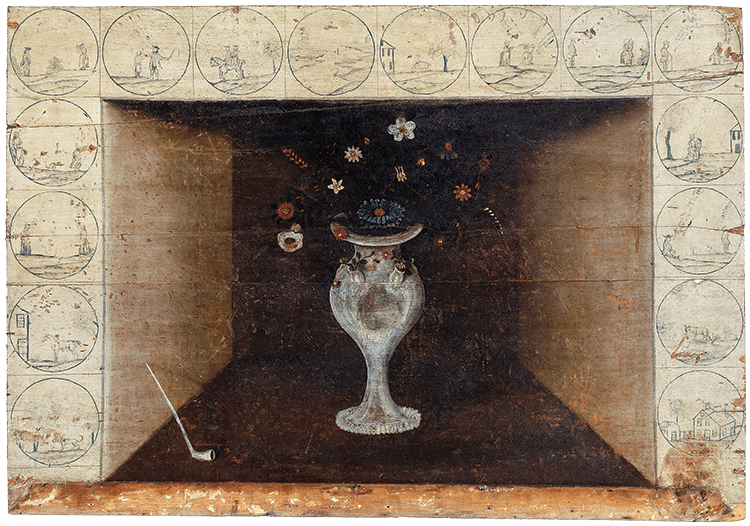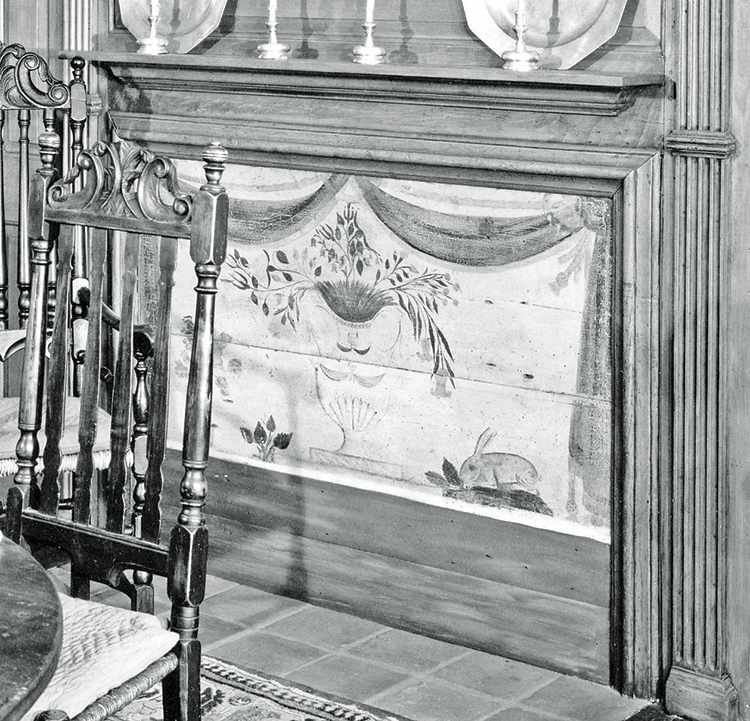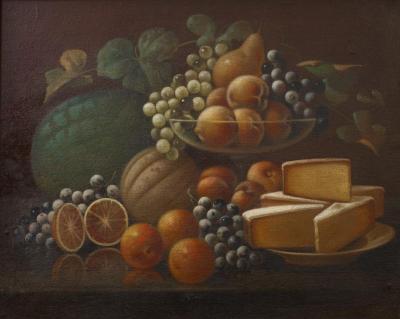"Tempus Fugit": A Connecticut Fireboard Attributed to Winthrop Chandler
In June 2014, a fireboard was auctioned at the Danielson family homestead in Killingly, Connecticut, where it had been since its creation (Fig.1). The oil-on-panel fireboard depicts a variety of flowers and cherries on long stems in a vase with handles, placed in a landscape. A bird perches on a flower stem with its bill open, about to catch a flying insect. Flanking the vase, a pair of smiling winged cherubs looks straight at the viewer. Below the cherub on the right, a hunched-over old man with a cane stands between two trees. Below the cherub on the left, a young man is fishing in a stream. There is a rabbit below the vase and another in the background, to the right.
There are several reasons to attribute the Danielson fireboard to Winthrop Chandler (1747–1790), a skilled artisan known best for his portraits and his landscapes that decorated interior walls and overmantels of homes mainly in the northeastern corner of Connecticut and nearby communities in Massachusetts.1 Chandler obtained most of his commissions from relatives and friends. The Danielsons and Chandlers had known each other for three generations. In 1703, Chandler’s grandfather settled Woodstock, Connecticut. In 1706, Sergeant James Danielson (1648–1728) purchased eight hundred acres in Pomfret, Connecticut, three miles directly south of Woodstock and, in 1707, he bought two thousand acres of land twelve miles away, which became the town of Killingly. Sergeant James Danielson was “one of the most prominent and influential men in that part of Connecticut,” as was Chandler’s grandfather.2 In 1724, Danielson deeded his land in Killingly to his eldest son, Samuel (1701–1785), who “succeeded to his father’s place in the community, which was much like that of an English country squire.” 3 Samuel’s eldest son, Colonel William Danielson (1729–1798), built the Danielson homestead in about 1760.
During the Revolution the Danielson and Chandler families became especially close. In 1774, William Danielson became the first major of the 11th Militia Regiment, and in 1775, he took 146 men from Killingly to join the Continental Army in the siege of Boston. Danielson became colonel of the regiment in 1776.4 Winthrop Chandler’s brother, Samuel, “was placed in command of the 11th Company of the 11th Regiment” of the militia.5 Thus, Colonel William Danielson was Captain Samuel Chandler’s commanding officer in the Revolution.
There are two other fireboards with vases of flowers attributed to Winthrop Chandler, both found in a tavern owned by Chandler’s cousin, Peter Chandler, in Pomfret, Connecticut. Both fireboards depict a vase with a variety of delicate flowers on long stems surrounded by painted images of Delft tiles.6 The tile on the top right corner of the fireboard in the Connecticut Historical Society features an old man with a cane (Fig. 2). The location of the other fireboard is presently unknown. A fourth fireboard attributed to Chandler (Fig. 3), with no associated history, also depicts a nearly identical vase, flowers, and leaves as in figure 1, but in a different arrangement and with a larger rabbit.7
The bird and rabbit motifs are similar to those found on Chandler overmantels beginning in the 1770s. The winged cherubs on Colonel Danielson’s fireboard, however, are unique for Chandler since they do not appear on any other Chandler work. Why are the winged cherubs included on this fireboard? Their frequent imagery as spandrels on eighteenth-century clock dials and on tombstones symbolically relay the passage of time. Their incorporation into Colonel Danielson’s fireboard relates to the visual theme of the stages of life: youth, old age, and the passage into eternal afterlife. These thoughts would likely have been on Colonel Danielson’s mind at the time since his father, Samuel, died in 1786, at the age of eighty-five; the old man with the cane may represent him. The colonel’s youngest son, William, his namesake, died in 1788 at the age of twenty; the young man fishing may represent him. The fireboard was likely painted in 1788–1789; commissioned by Danielson not only as a commemoration of two family members who were dear to him, but also as a consoling reminder that man ultimately passes into a world of eternal life—as represented by the smiling winged cherubs.8 This fireboard may well have been one of Chandler’s last works; he died in 1790.
Leslie and Peter Warwick are independent researchers and collectors of American antiques and folk art. They wish to thank Elliott and Grace Snyder, who asked for their help in researching the fireboard, which led to further discoveries and this article.
This article was originally published in the Anniversary 2015 issue of Antiques & Fine Art magazine, a digitized version of which is available on afamag.com. Antiques & Fine Art, AFAmag, AFAnews, and AFA Publishing are affiliated with InCollect.com.
2. Descendants of Sergeant James Danielson, Generation One, http://freepages.genealogy.rootsweb.ancestry.com/~batemanp/pilgrims/test0002.htm.
3. Descendants of Sergeant James Danielson.
4. Descendants of Sergeant James Danielson, Generation Three. Colonel William Danielson, Notes from family records.
5. Nina Fletcher Little, “Winthrop Chandler 1747–1790,” in Jean Lipman and Tom Armstrong, ed., American Folk Painters of Three Centuries (New York: Hudson Hill Press, 1980), 33.
6. Verbal communication with Richard Malley, head of research and collections at the Connecticut Historical Society.
7. Illustrated in Alice Winchester, “Period Rooms for New Hampshire,” The Magazine Antiques (December 1958): 533. Courtesy, New Hampshire Historical Society.
8. Tom Devonshire Jones, Linda Murray, and Peter Murray, eds., The Oxford Dictionary
of Christian Art and Architecture (Oxford University Press), 68.



































